Despite a softening motorcycle market in Malaysia, Kawasaki Motorcycles Malaysia has taken the bold step of introducing not one, but four new models for 2017. These are the Kawasaki Z900, the Versys X-250, and for the middleweight market, the Ninja 650 and Z650.
The previous iteration of Kawasaki’s middleweights, the ER-6n and ER-6f, proved to be solid performers and best-sellers locally, due to the very attractive price and easy-to-ride performance. But, both models were showing their age, and the new Ninja 650 and Z650 are designed to fill that niche.
At the face of it, it appears as if the new Ninja and Z are merely facelifted models of the previous parallel-twin engine, but this is not so. Coming with an all new engine, frame and swingarm, plus the addition of ABS, the 2017 Ninja 650 and Z650 are all-new models in Kawasaki’s line up.
Biggest difference between the two new 650s from Kawasaki is of course the design. The Ninja 650 carries a full-fairing with design cues taken from the ZX-10R litre-class sports bike, while the Z650 is a naked sportsbike with Kawasaki’s “Sugomi” design style.
During a media ride organised by Kawasaki Malaysia, we were given the opprtunity to take both machines out for a short run on a mix of country roads and highways, to see what improvements and changes were made to the new middleweights and what has been improved, or not, as the case may be.
Following up a successful model run like the ER-6 series is not easy. While the ER-6 might not have been the most advanced of motorcycles, a value-for-money price made it very popular locally, sort of like the bike world equivalent of the Proton Wira.
So, for the new generation middleweight, Kawasaki’s direction was pretty much clear. Setting a goal of making the Ninja 650 and Z650 “lightweight, compact, easy-to-ride and superb handling”, we went forth to find out if this was true.
Since both bikes share the same engine and chassis, this article will address both bikes as a single unit. There is no real change in the engine layout, still the same 649 cc, liquid-cooled parallel-twin, with DOHC and eight-valves.
What has changed is the dual-throttle valves of the EFI, which smooths out the fuelling curve, and gives a linear throttle response. We found this to be true on the road, as whacking the throttle open didn’t make the engine hesitate on take-off.
The engine’s torque curve is now meatier in the mid-range, while peak power is down very slightly from 2016, but puts the power where the rider can make the most use of it. While having a high hp figure is nice for bragging rights, in the real world, having an engine that’s responsive between 4,000 to 8,000 rpm, where most people do their riding, makes more sense.
Claiming 68 PS at 8,000 rpm and 65.7 Nm at 6,500 rpm, the Ninja and Z650 are not going to surprise anyone with the numbers. But, as we were to find out, there is a big difference between what the numbers say and how the bike actually behaves on the road.
On the chassis side of things, the trellis frame is now patterned after the electric-green affair from the Kawasaki H2, and weighs 15 kg. This is coupled with a cast alloy swingarm, replacing the welded steel affair on the previous generation ER-6.
Suspension is still with non-adjustable telescopic forks in front, not really a surprise at this price point. However, the rear monoshock is now located to the middle of the frame, instead of to the side.
Absorber length has gone to 292 mm from 296 mm to provide better suspension compliance, with adjustable pre-load. Seat height for both the Kawasaki Ninja 650 and Z650 is set at 790 mm, which will make it popular with many riders, especially in stop-and-go traffic.
Physically, both Kawasaki middleweights are small, something we noticed at the first approach. The nearest comparison we could give it would be like if someone had taken a Z250 and shoehorned a 650 cc engine in.
And this is not a bad thing, for the Ninja 650 and Z650 both weigh a lot less than their predecessors. According to published figures, the 2017 Kawasaki Z650 weighs a claimed 187 kg, while the full-fairing Ninja 650 comes in at 193 kg, compared to the 196 kg and 211 kg for the ER-6n and ER-6f, respectively.
Riding out, we sampled the Kawasaki Z650 first, and took it out on some slightly curvy country roads, under police escort. The first thing we noticed was the very nimble and light handling of the Z650.
When Kawasaki said the bike had gone on a diet, it wasn’t kidding. The Z650 was light and very responsive, without that over-controlled feeling that sometimes comes with bikes with wide bars.
Throwing the Z650 into the corners did not require a second thought, just point and shoot. Grip and suspension response was just fine at the 90 to 110 km/h speeds we were riding at, and the suspension did not bottom out, despite this rider’s best efforts at finding the biggest bumps and potholes around.
Roll-on torque was another thing that surprised us on the Z650, with the surge forward in fourth gear, while not at “oh my god, I’m going to die” levels, was enough for rapid overtaking and catching up with the ride leader, though the engine had to be at the proper gear for the action to happen.
While the roll-on torque is much better than the previous ER-6, this is still a middeweight with two cylinders, so proper gear selection is of paramount importance. This is because the engine would chug and bog down in top gear roll-ons, a function of the engine’s design and torque curve.
We did notice a lot of high-frequency vibration coming through the handlebars, though it was negligible in the seat and foot-pegs. We spoke to Kawasaki Malaysia’s marketing head, and he said the handlebar end weights had already been increased, but would take our feedback into account.
Braking on the Z650 and Ninja 650 is with dual 300 mm diameter floating discs in front, grabbed by new dual-piston callipers, while the rear is a single 220 mm disc. ABS is now standard in Kawasaki’s middleweight range, and this is a good thing, regardless of regulatory requirements.
There wasn’t really a chance to test the ABS, but we did try hard braking on a small patch of sand. The ABS light came on and flickered, the brake lever pulsed so quickly we almost didn’t feel it, and that was that.
Suffice it to say, the ABS worked, the brakes provided adequate feel and response, and the whole system felt balanced. Which, at this price point, was a very pleasant surprise indeed.
We would also use the word balanced to describe both the Ninja 650 and Z650, as it was clear a lot of thought had gone into making both bikes feel controllable and easy to ride within their respective performance envelopes.
After stopping for a break, we swapped over for the Ninja 650. Styled as an out-and-out sportsbike, the Ninja 650 takes the nose of the ZX-10R, along with a cast single-unit handlebar, and turns the base 650 into machine with racing looks. The unit we rode was the SE version of the Ninja 650, which comes with a single-seat cowl.
The riding position of the Ninja 650 drops the rider about an inch lower at the hands, though the seat to foot-ratio remains about the same. Setting off on the Ninja 650, we found that the riding position, while fine for normal, up-right riding, was a trifle cramped in the racing position.
With a small screen on the front fairing, we expected to have more protection from the wind blast compared to the Z650, but found differently. For our 1.7-metre tall rider, the wind came in straight to the chest, with the helmet buffeting when speeds reached the 150 km/h mark.
This could be addressed with a slightly taller screen, or ducking down under the wind blast somewhat, but the small fore-aft seat distance made this a little difficult for our slightly oversized rider. So, if you really want a Ninja 650, make sure you’re a whippet-weight jockey.
Along the return ride, we were given the chance to try and bring the Ninja 650 to top speed, with the caveat we were not to overtake the lead police escort. Whacking open the throttle, we got an indicated 180 km/h before having to back off.
There certainly was more “go” in the bike though, and we got reports of the 650s reaching close to 200 km/h. Note, this was done on a stretch of highway under police escort, professional rider, no animals or moto-journalists were harmed in the writing of this article, etc.
Handling for the Ninja 650 followed that of the Z650, with the cornering precise and controllable, and little effort required. Since both bikes share an identical chassis, entries, lines and exits were similar, though the Ninja 650’s slightly lower riding position in the bars encouraged more counter-steering and later corner entry.
General comfort for the Ninja 650 and Z650 was similar, save the vibration in the handlebars, of which there was a lot less of in the Ninja. We put this down the heavier bar assembly, and if we were to have to ride the Z650 on a daily basis, something from the aftermarket would have to be installed.
The 2017 Kawasaki Z650 is priced at RM35,609, with two colour choices – Lime Green or Titanium. Meanwhile, the 2017 Kawasaki Ninja 650 goes for RM37,189, while the Special Edition retails for RM38,189 with Candy Burnt Orange for the base model, and the Special Edition comes in Kawasaki Green. All prices include GST, but exclude insurance, registration and road tax.
GALLERY: 2017 Kawasaki Z650 – Titanium
GALLERY: 2017 Kawasaki Ninja 650 – Candy Burnt Orange
GALLERY: 2017 Kawasaki Ninja 650 SE

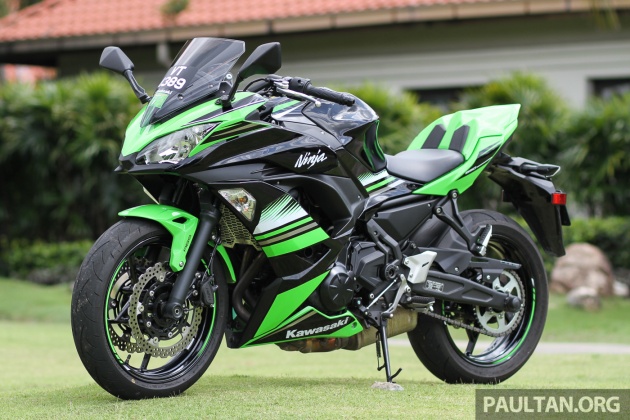


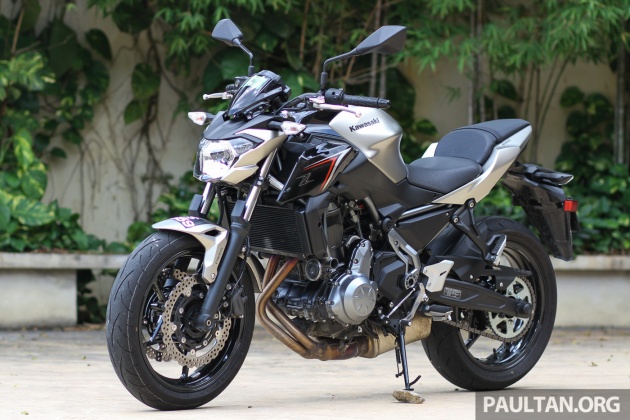
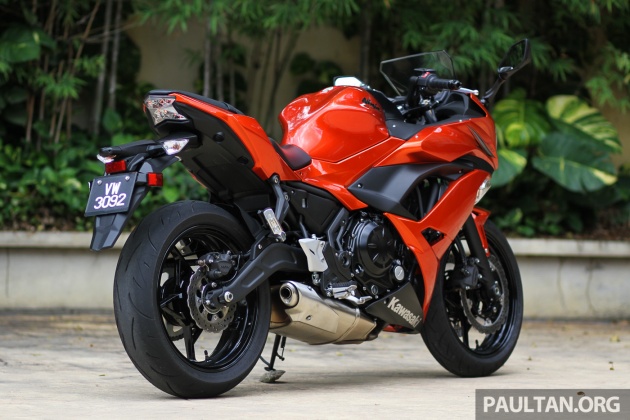



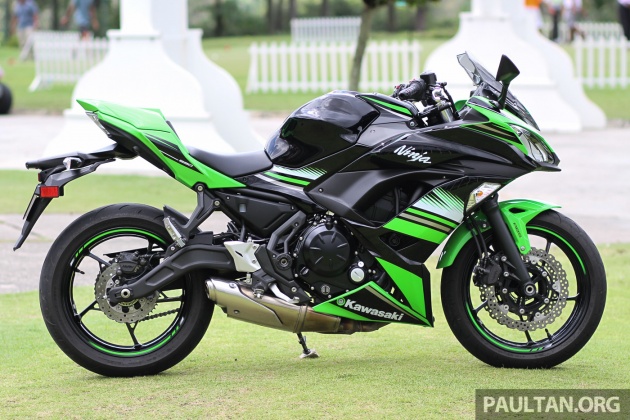
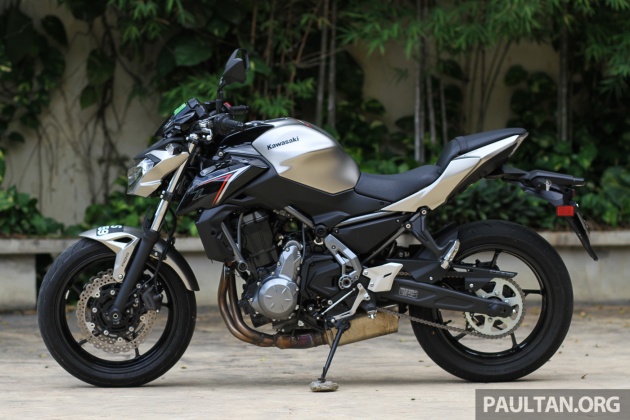



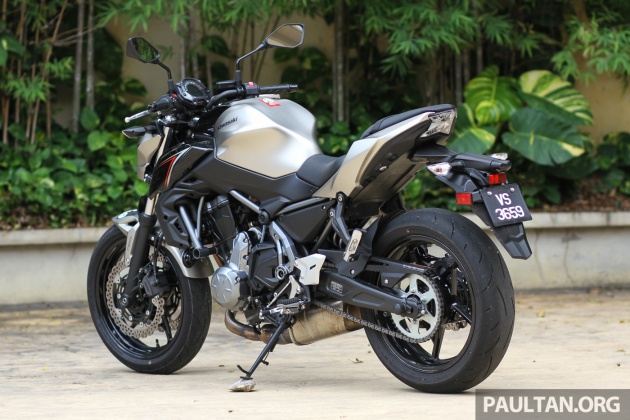



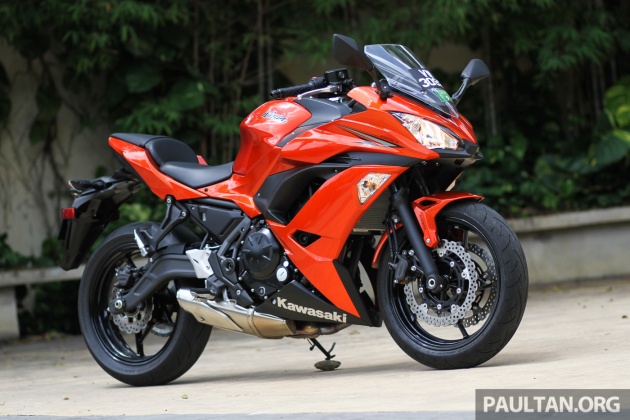
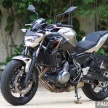
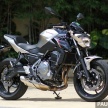
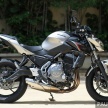
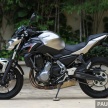

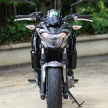
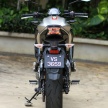
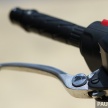
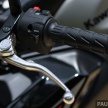

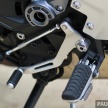
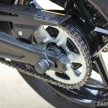
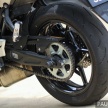
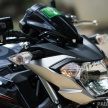
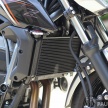
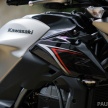
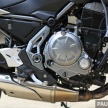
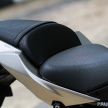
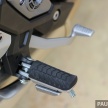
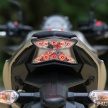
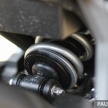
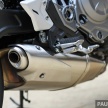
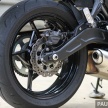
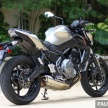
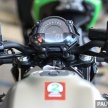
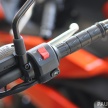
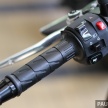
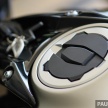
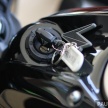
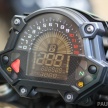
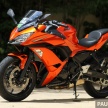
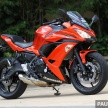
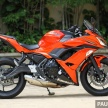
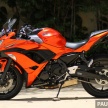
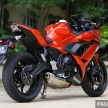
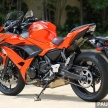
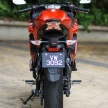
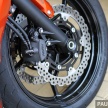
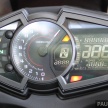
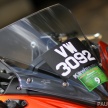
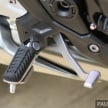
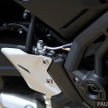
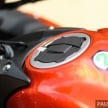
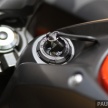
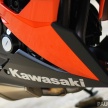
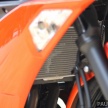
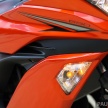
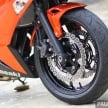
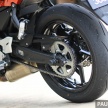
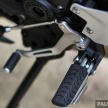
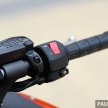
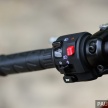
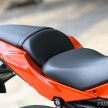
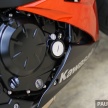
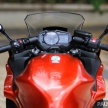
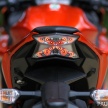
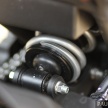
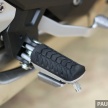
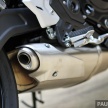
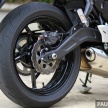
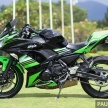
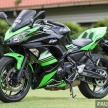
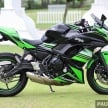
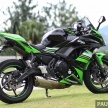
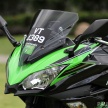
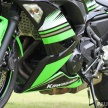
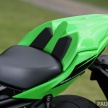
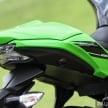
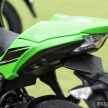
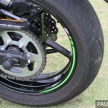
Love the new rear lamp style
Compare z650 with mt-07, which one give greater fun?
What is the Best way 2 find out ?? U will only know if U buy both & ride it to know. After that, U can write & post here as a Guest writer & share your experience. That way, NO one dare to tell U which one is better bcos U have own/used both.
Lastly, don’t trust anyone but yourself. Buy what U NEED & NOT what U WANT. That is the only advice I can give to U at this point in time. Shalom & Cheers …
At this price point, the mt07 is definitely the way to go. Save for the abs, the mt07 looks better, sounds better, performs better, weight lighter, and cheaper. But as mikey said,test ride is the best way to find out.
Anyway, really great reviews. The bike section keeps getting better these days
My opinion will be mt 07 due to its 270 crank (which exhaust note almost similar to a vtwin) larger rear wheel (180 as oppose to kawasaki using 160) and higher hp
Though mt 07 suffer from unimpressed rear suspension and the dashboard and the key location are stupidly design
And biggest of it all is lack of ABS which should be norm amongst the japs
Price both are competitive
That batu under stand, lol
haha. didnt realise until you mentioned. LMAO ..
Now that’s a proper impression
The biggest break will be the inclusion of the ABS as standard from now on
The downside is probably the price, huge jump from 36k on previous gen
The fairing version also a deal breaker since their only competitor is the no frill Honda cb 500r which lack power and abs but far more cheaper at 30k